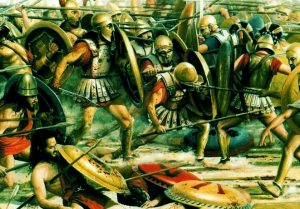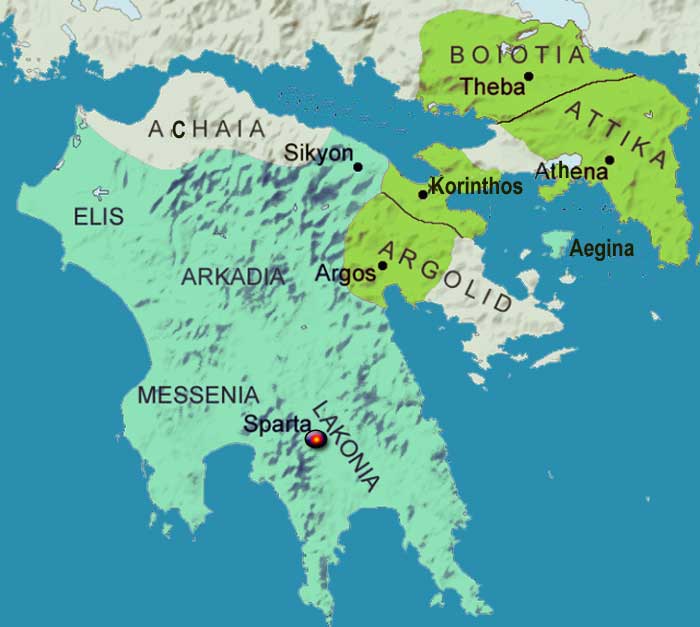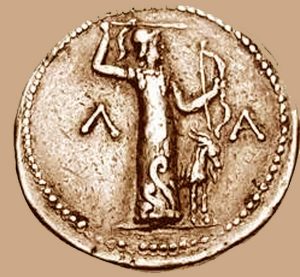History of Ancient Sparta
 The ancient kingdom of Sparta was a city-state in Ancient Greece, built on the banks of the river Evrotas in Laconia, in the SE part of the Peloponnese. She has become known in world history for her military prowess, discipline, heroism and large number of slaves.
The ancient kingdom of Sparta was a city-state in Ancient Greece, built on the banks of the river Evrotas in Laconia, in the SE part of the Peloponnese. She has become known in world history for her military prowess, discipline, heroism and large number of slaves.
It is also known in Greek Mythology, mainly for the myth of the Beautiful Helen. The military power of Sparta was due to the system of Education that had been imposed by the legislation of Lycurgus, something that was unique in ancient Greece.
It is difficult for modern scholars to reconstruct the prehistory of Ancient Sparta, as the written sources are very distant in time from the events, which had already been greatly distorted by the oral tradition. However, the oldest reliable evidence of human settlement in the area of Sparta is the finding of pottery dating to the Middle Neolithic period near Koufovouno, about 2 km SW of the city.
These are the most ancient traces of the authentic Mycenaean Spartan civilization, which is referred in Homer’s Iliad. This civilization seems to have declined towards the end of the Bronze Age, when Greek warlike tribes of Dorians from Epirus and Macedonia descended and settled in the Peloponnese.
MYTHOLOGY
Pausanias, provides rich information about the mythological origin of many of the characteristic of Sparta. According to the Spartans, the first king of their countryv was Lelegas and from his name the inhabitants were called Leleges. The king had two children: Myli and Polykaonas. The second married the daughter of the king of Argos Triopas, the beautiful Messina. She, realizing that her second-born husband would never become king, urged him to leave the country. Crossing the mountains they discovered a large and fertile plain. There they built a city, Messina. Polycaon became king of the country he named after his wife, Messinia.
Lelegas was succeeded by Mylis and Mylis by Evrotas. This intelligent king inspired a grandiose work. The valley where his country was located was flooded by a river forming a large lake. With the construction of a canal, the river was limited to its bed, leaving the fertile valley free. So the river was named after the king, Evrotas. Eurotas left no male descendants, but a daughter, Sparta.
Her fiancé, Lacedaemon, was appointed successor. This king gave his name to his country. He built a city for his capital, which he named Sparta, honoring his wife. He also gave the name of his mother, Taygetis, to the big mountain, which separated his country from Messinia. Finally, his son, Amyklas, left his name in history, building a city known as Amykla. It is noted that the descendants of these persons were, according to the oral tradition, the heroes of the Trojan cycle: Eleni, Clytemnestra, Dioscuri and Penelope.

HISTORICAL PERIOD
 The historical period of Sparta begins after the Descent of the Dorians around 1100 BC. and ends during the Roman occupation, although there is clear evidence of the influence of Mycenaean Civilization in the area long before the arrival of the Dorians, which is considered the prehistory of Ancient Sparta. During Classical Antiquity, Sparta was one of the two most powerful city-states in Ancient Greece, along with Athens.
The historical period of Sparta begins after the Descent of the Dorians around 1100 BC. and ends during the Roman occupation, although there is clear evidence of the influence of Mycenaean Civilization in the area long before the arrival of the Dorians, which is considered the prehistory of Ancient Sparta. During Classical Antiquity, Sparta was one of the two most powerful city-states in Ancient Greece, along with Athens.
The Dorians apparently began to expand the borders of the Spartan territory before establishing their own state. They fought against the Dorians of Argos in the east and south east, as well as the Arcadians Achaeans in the north west. There are also indications that Sparta itself, extremely inaccessible due to the topography of the Taygetos valley that was considered quite safe from that time, so it was never fortified.
Between the 8th and 7th century BC.
The Spartans experienced a period of anarchy and internal conflicts, for which both Herodotus and Thucydides testify. As a result, they undertook a series of political and social reforms which they later attributed to a semi-mythical legislator, Lycurgus. These reforms mark the rise of Classical Sparta.
Sparta began to emerge as a political-military force in Greece at the beginning of the Archaic Age, after the end of the dark years of the Geometric Age and reached its absolute prosperity after its victory in the Peloponnesian War over Athens and its allies, when and succeeded in imposing its hegemony and influence on most of the ancient Greek world.
According to Thucydides, in the 5th century BC, the Spartan state extended to the most of the Peloponnese approximately 8,500 sq. Km., An area three times that of Athena. It included two main areas, separated by mountain ranges.
Laconia, if we want to define it strictly, is limited to the west by Mount Taygetos, while to the south and east by the Myrtos Sea. Its borders to the north were volatile: in 545 BC. Sparta, with its king Echestratus, conquered the fertile plain of Kynouria, which according to legend had been colonized by Kynouros, son of Perseus from Argos.
Since then the borders of the area pass through the outskirts of Thyrea (near the modern Astros), the area of the Earl of Tire and the Greens were the natural borders and were never lost from Sparta, the southern part of the Parthenian mountains, the valley of Evrota (including Skyritida) and then the area at the foot of Helmos, which is identified with Velminatida.
Messinia, conquered during the Messinian wars, is enclosed to the north by the river Neda and the Arcadian Mountains, to the east by Mount Taygetos, to the south by the Messinian Gulf and to the west by the Ionian Sea. It includes large mountains, including the mountains of Kyparissia and Ithomi. In the middle is the valley of Messinia, which is flooded by the river Pamisos.
CLASSICAL SPARTA
During the Second Messinian War, Sparta emerged as a great power both locally and nationwide. In the following centuries, the fame of the Spartan military force was not worthy of it. In 480 BC. a small force of Spartans, Thespians and Thebans led by King Leonidas waged a legendary battle to the end in Thermopylae against the colossal Persian army, inflicting innumerable losses before it was finally encircled.
The superiority of the equipment and the military art of the hoplites of the Spartan phalanx was seen again a year later when the Spartan army, this time in quorum, led a combined force of Greek cities against the Persians in Plataea.
The decisive victory at the Battle of Plataea put an end to the Persian Wars, as well as to the ambition of the Persians to expand into European territories. Although the battle was ended by an army of men from all over the Greek world, praise was given to Sparta, which in addition to starring in Thermopylae and Plataea, was the de facto leader of the Greek campaign.
During the Late Classical period, Sparta, along with Athens, Thebes, and the Persian Empire, were the main forces fighting each other for supremacy. As a result of the outbreak of the Peloponnesian War, Sparta, traditionally a land culture, became a powerful naval power.
At the height of its power, it forced many of the most important Greek city-states to defeat, finally managing to impose itself on the mighty Athenian fleet. Towards the end of the 5th century BC, Sparta stood out as the force that had defeated Athens and invaded Persia, a period also known as the “Spartan hegemony”.
THE DECLINE OF ANCIENT SPARTA
Its hegemony did not last long and after its defeats by the Thebans in 371 BC. in Lefkra and in 362 BC. in Mantineia lost its old power and with the rise of the kingdom of Macedonia began to play a minor role in Greek affairs. Some flashes in the 3rd century BC. they did not prevent its decline following the fate of the rest of the Greek world conquered by the Romans. However, even during the Roman occupation, it continued to be a pole of attraction, due to its rich history.
